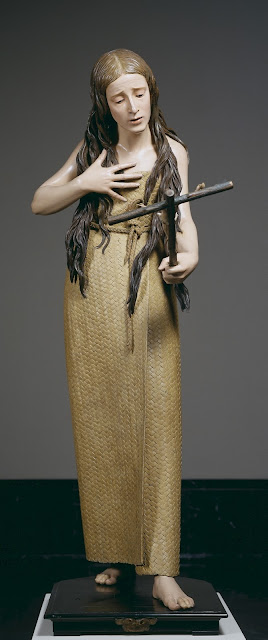Pedro de Mena was a Spanish sculptor who is considered to be the most famous representative of the Granada strand of the Baroque school of sculpture in Spain. He dedicated his life's work to producing sculptures depicting religious imagery, just as his father had done before him.
Pedro de Mena (Spanish, Granada 1628–1688 Málaga)
Mater Dolorosa, ca. 1674–85
Partial-gilt polychrome wood
24 13/16 × 23 1/8 × 15 in. (63 × 58.7 × 38.1 cm
The Metropolitan Museum of Art
Carved wood sculpture, enhanced by paint and other media, including glass eyes and hair, reached a pinnacle of naturalism and expressive force in 17th-century Spain. Pedro de Mena’s virtuoso manipulation of these materials created startling likenesses of bodies and clothing. They encourage in the beholder an empathetic response. The Virgin’s thin, deeply undercut drapery are joined by the subtle and descriptive painting in thin glazes of the silver and red brocade of the Virgin’s tunic. Mena’s desire was to make the figures seem physically present before the viewer. At the same time, they have a dignity and reserve that made them ideal works for contemplation. More Pedro de Mena sculpture
Pedro de Mena was born and baptised in Granada. He began studying art and sculpture under his father, Alonso de Mena. His father died in 1646 and Pedro had to take over the workshop himself at the age of eighteen. From 1652, Pedro de Mena would also share this workshop with another famous Spanish sculptor and artist, Alonso Cano. As a result, the pair worked together and collaborated on many projects during their lives.
Attributed to Pedro de Mena (Spanish, 1628–1688)
Dolorosa
51 x 29 x 43 cm. (20.1 x 11.4 x 16.9 in.)
Private Collection
Pedro de Mena's work became famous across the Spanish peninsular. He began working with his son, Alonso, in order to complete some of the many commissions he received, which can be found in Jesuit temples in places such as Madrid, Marchena, Seville, and even in the cities of Mexico and Lima.
Pedro was an extremely religious Spanish sculptor. He fought hard to be made a member of the Inquisition. He eventually became a member in 1678, which had lots of perks for him and his family. Firstly of all, it meant that Pedro de Mena had been publicly recognised to be of pure blood. Most importantly however, it guaranteed Pedro de Mena and his family the freedom of not having to pay taxes.
Circle of Pedro de Mena (Spanish, 1628–1688)
Mater Dolorosa , ca. 1670–1675
Painted wood and glass
78 x 49 x 40 cm. (30.7 x 19.3 x 15.7 in.)
Private Collection
In 1679, Pedro de Mena fell very ill with the plague; however, he was fortunate to survive, albeit with a few prolonged side effects. After this, Pedro de Mena decided to let his disciple, Miguel Félix de Zayas, run his workshop. Pedro de Mena's illness meant that for the rest of his life he was limited to only helping out in the workshop by producing some drawings and sketches. He died in 1688 and was buried, as he had requested, in the Císter Convent in Málaga. More Pedro de Mena
Pedro de Mena (Spanish, 1628–1688)
Mater Dolorosa (Virgin of Sorrows)
Polychromed wood, ivory and glass
CARMELITE MUSEUM, CARMUS, Salamanca
Between 1673 and 1678 Pedro de Mena carved the half-bust polychrome, of fine sheets that give great plasticity and movement to the folds, incorporating buttons, borders, teeth of ivory, horn nails and eyes of vitreous paste that give a great verisimilitude. It is in a window, with central window and other narrower sides.
Circle of Pedro de Mena (Spanish, 1628–1688)
Mater Dolorosa (Virgin of Sorrows)
The Weeping Virgin
Polychromed wood, ivory and glass
40 cm. (15.7 in.)
Fitzwilliam Museum, Cambridge
Circle of Pedro de Mena (Spanish, 1628–1688)
Mater Dolorosa (Virgin of Sorrows)
The Weeping Virgin
Detail
Circle of Pedro de Mena (Spanish, 1628–1688)
Mater Dolorosa (Virgin of Sorrows)
Polychrome wood carving
Pedro de Mena (1628–1688)
Virgin of Bethlehem, c. 1670 and 1675
Polychrome wood carving
Santa Maria de la Victoria, Malaga
Pedro de Mena (1628–1688)
Virgin of Bethlehem, c. 1670 and 1675
Another view
Pedro de Mena (1628–1688)
La Dolorosa
Polychrome wood carving
González Abreu Collection
Pedro de Mena (1628–1688)
Mater Dolorosa, c. mid 17th century
Polychrome wood carving
68 cm x 65 cm x 54 cm
Real Academia de Bellas Artes de San Fernando
Pedro de Mena (1628–1688)
Mater Dolorosa, c. mid 17th century
Polychrome wood carving
Convent of the Salesians
Pedro de Mena (Spanish, 1628–1688)
Dolorosa
Wood Painted
25.8 cm. (10.2 in.)
Private Collection
After Pedro de Mena (1628–1688)
Mary Magdalene Meditating on the Crucifixion, c. late 1660s
Painted cedar, glass, and horn (for fingernails)
64 3/16 in. (163 cm)
Church of San Miguel, Valladolid
This is one of Mena's most personal creations and a masterpiece of Spanish sculpture thanks to the masterly fusion of naturalistic polychromy, skilled sculpting and expression of repentance. Wrapped in a mat of woven palm, her face marked by penance, the holy penitent turns her gaze to the crucifix as her hand draws a gesture of mystical ecstasy. More Mary Magdalene Penitent
Pedro de Mena (1628–1688)
Penitent Mary Magdalene, c. 1664
Polychromed Wood
Medium
High/Height: 171 cm.; Width: 52 cm.; Base/bottom: 61 cm.
Museo Nacional del Prado, Madrid
Acknowledgement: ArtNet, and others
Images are copyright of their respective owners, assignees or others
We do not sell art prints, framed posters or reproductions. Ads are shown only to compensate the hosting expenses.
If you enjoyed this post, please share with friends and family.















INCLINE, O Maiden,
ReplyDeleteThou sorrow-laden,
Thy gracious countenance upon my pain !
The sword Thy heart in,
With anguish smarting,
Thou lookest up to where Thy Son is slain !
Thou seest the Father ;
Thy sad sighs gather.
And bear aloft Thy sorrow and His pain !